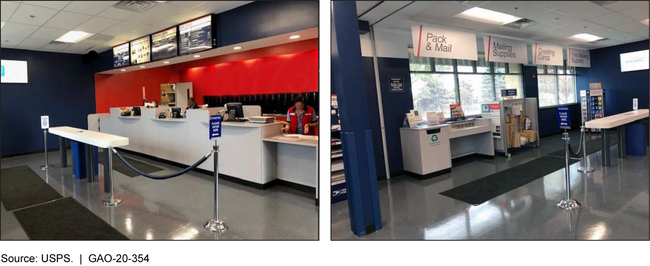U.S. Postal Service: Expanding Nonpostal Products and Services at Retail Facilities Could Result in Benefits, but May Have Limited Viability
Fast Facts
The U.S. Postal Service has over 31,000 retail facilities—a network reaching into almost every community in the nation. As demand for some mail products has declined, USPS has been unable to cover its costs as it is required to do—putting it on our High Risk list.
A task force and others have suggested allowing USPS to offer additional services at its facilities, such as hunting licenses, to generate revenue and other benefits.
We asked postmasters and industry and consumer representatives about potential services. They said that some—like banking—could expand consumer access. But adding services may require additional expertise or resources.

Inside a post office
Highlights
What GAO Found
In 2018, U.S. Postal Service's (USPS) retail facilities, such as post offices, generated about $10.5 billion in revenue and cost approximately $5 billion to operate, making them profitable overall. While such facilities accounted for about 15 percent of USPS's total fiscal year 2018 revenues, and about 7 percent of its total costs, stakeholders identified other benefits that retail facilities provide for communities—particularly in rural areas—such as local access to government information and services.
Example of a U.S. Postal Service Retail Facility Lobby

Since 2008, USPS has offered a variety of nonpostal products and services at its retail facilities that have generated some revenue and other benefits. USPS data show that the nonpostal products and services for which USPS captures revenue data, such as money orders, generated about $431 million in total revenue in fiscal year 2018 and were profitable overall. Stakeholders said many of these nonpostal products and services also provided other benefits, such as enhanced convenience for customers, and postmasters GAO surveyed said some offerings, such as passport services, were highly valued in their communities.
Offering additional nonpostal products and services at USPS retail facilities could provide consumer, government, or community benefits, but viability may be limited. Stakeholders said new offerings, such as expanded financial products or government services could, for example, enhance consumers' access and government efficiencies. In particular, some noted that USPS could provide a viable banking alternative for those lacking banking services. However, USPS officials, postmasters GAO surveyed, and stakeholders GAO interviewed said that additional offerings may generate minimal revenue and that USPS may face factors limiting the viability of these offerings. For example, groups representing states' licensing agencies said offering state hunting and fishing licenses could be problematic given different state requirements. Also, stakeholders said USPS may not have the expertise nor the required capital to enter the market of some of these new offerings. Given such concerns, USPS and policy makers need to carefully weigh costs, benefits, and limitations of any new offerings.
Why GAO Did This Study
USPS manages over 31,000 retail facilities, which help it provide postal services throughout the country. However, USPS faces financial challenges. In general, USPS is prohibited by statute from providing nonpostal products and services (i.e., services not directly related to mail delivery) unless approved by the Postal Regulatory Commission. But given the ubiquity of the retail network, some stakeholders have suggested that offering additional nonpostal products and services could help USPS generate revenue and provide benefits for consumers and communities.
GAO was asked to review opportunities to enhance the value of USPS's retail facilities. This report examines: (1) the costs, revenues, and other benefits associated with USPS's retail facilities; (2) USPS's nonpostal efforts since 2008 at retail facilities and the outcomes; and (3) considerations of new nonpostal efforts at retail facilities. GAO analyzed USPS retail facility costs and revenue data from fiscal years 2017 and 2018 (the only years available); reviewed relevant documents and reports from USPS and others; conducted a non-generalizable survey of USPS postmasters who managed rural, suburban, and urban retail facilities; and interviewed USPS officials, and stakeholders, including postal employee unions, industry and consumer groups, and federal agencies that partner with USPS to obtain views on current and potential nonpostal efforts.
GAO is making no recommendations. USPS, in its comments, reiterated that it faces various constraints to new offerings at retail facilities.
For more information, contact Lori Rectanus at (202) 512-2834 or rectanusl@gao.gov.
